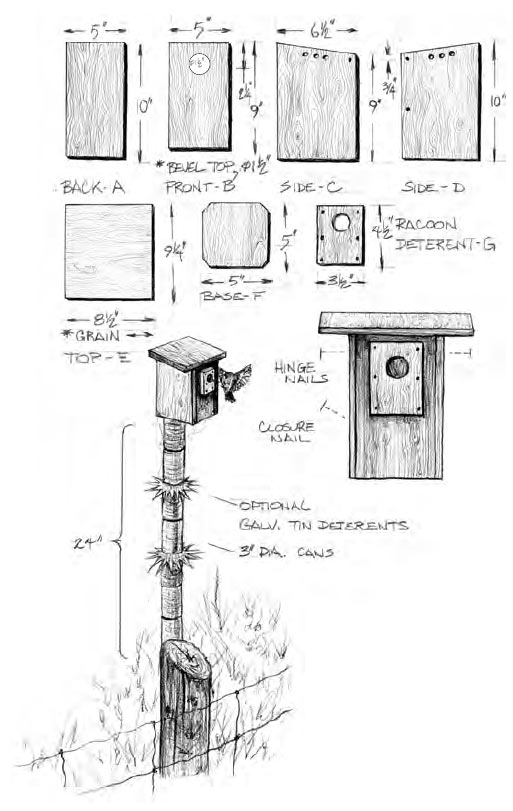
Hazel Bird’s Eastern Bluebird Nesting Box Design
After years of trial and error, Hazel Bird and the Willow Beach Field Naturalists have arrived at a bluebird nest box design that stands up to predators.
Step 1. Cut out pieces A through G. Don’t forget to remove corners from base (F) for drainage. Bevel top of front (B) to allow for smooth opening and closure.
Step 2. Drill 1/4 inch ventilation holes in sides (C & D) as per diagram.
Step 3. Drill 1/8 inch holes for hinges on short sides of each sidewall (C & D). Each hole should be 3/4 inch from top of board and 3/8 inch from sidewalls(C & D).
Step 4. Nail raccoon deterrent (G) to front wall (B).
Step 5. Nail 2 sides (C & D) to outside of back panel (A).
Step 6. Attach base (B) to back panel and sides (A, C, and D).
Step 7. Put front (B) in place and tap in hinge nails.
Step 9. Drill hole site for closure nail at a slightly downward angle.
Step 10. Nail on roof (E) flush to the back and overhanging in the front.
The bottom of the nesting box should be 7 feet off the ground to discourage raccoons and other predators. Attach the box to a 1″x 3″ board that is at least 4 feet long. Thread at least 6 tin cans that are 3 inches in diameter on to the 1″x 3″ board below the nest box, to deter predators. Nail 1″x 3″ board to fence post.
If predator problems persist, cut out galvanized tin star shapes and add them between tin cans.
Locate the nest boxes in open areas, not in hay or corn fields. Short grass pastures are ideal locations.
The box should face south, South-East or East.
Clean out the boxes after each nesting. May the bluebirds bless your spring!
Story by:
John Napes